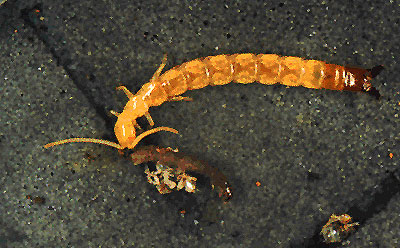 |
Class
and Order - DIPLURA
(Greek, diploos= two; oura= tail)
Common Names: none
Distribution: Cosmopolitan
Description
Diplura are small arthropods closely related to insects. Diplurans are
5-50 mm in length and narrow-bodied. They lack compound eyes but may have
light sensitive spots on their heads called pseudoculi. Antennae resemble
a chain of beads (moniliform). Legs are 5-segmented. Body colour is
usually very pale and they are always wingless. The abdomen always has 10
segments and is quite long. A characteristic of the order Diplura is that
the last segment of the abdomen has two appendages (cerci) which may be
long and hair-like, or short and curved resembling the pincers of earwigs.
Nymph
There is no metamorphic cycle of egg-larva-pupa-adult. The young nymphs
emerge from the eggs and resemble the adult. Nymphs grow through successive
moults. Moulting continues throughout the adult stage. Some species exhibit
maternal behaviour by protecting both eggs and nymphs.
Members
Common names are not given for members of this order.
Food
Diplurans with abdominal pincers are predators. These arthropods burrow into
soft, moist soil so that only the abdominal pincers are exposed. If a passing
slater or small insect passes near the pincers, it is captured and dragged into
the burrow to be consumed. Other diplurans feed on decaying vegetation.
Importance
Diplurans have no known economic importance. The presence of some species in
the food chains of ecosystems implies a part in the re-cycling of plant material
in forests.